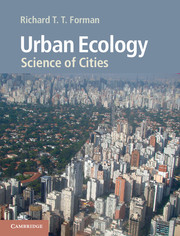Book contents
- Frontmatter
- Dedication
- Contents
- Foreword
- Preface
- Acknowledgments
- Part I Framework
- 1 Foundations
- 2 Spatial patterns and mosaics
- 3 Flows, movements, change
- Part II Ecological features
- Part III Urban features
- Epilogue
- Appendix A Positive and negative attributes of an urban region
- Appendix B Equations
- References
- Index
2 - Spatial patterns and mosaics
Published online by Cambridge University Press: 05 June 2014
- Frontmatter
- Dedication
- Contents
- Foreword
- Preface
- Acknowledgments
- Part I Framework
- 1 Foundations
- 2 Spatial patterns and mosaics
- 3 Flows, movements, change
- Part II Ecological features
- Part III Urban features
- Epilogue
- Appendix A Positive and negative attributes of an urban region
- Appendix B Equations
- References
- Index
Summary
Towns don’t want to be suburbs, suburbs don’t want to be cities, and cities don’t want to be wastelands.
Michael Dukakis, quoted in Conservation and Values, 1978If you know one of their cities, you know them all, for they’re exactly alike … Amaurot lies up against a gently sloping hill; the town is almost square in shape. From a little below the crest of the hill, it runs down about two miles to the river. … the water runs clean and sweet all the way to the sea … another stream, not particularly large, but very gentle and pleasant, which rises out of the hill, flows down through the center of town … The town is surrounded by a thick, high wall … The streets are conveniently laid out for use by vehicles and for protection from the wind. Their buildings are by no means paltry; the unbroken rows of houses facing each other across the streets through the different wards make a fine sight. The streets are twenty feet wide. Behind each row of houses at the center of every block and extending the full length of the street, there are large gardens. Every house has a door to the street and another to the garden … They raise vines, fruits, herbs, and flowers, so thrifty and flourishing that I have never seen any gardens more productive or elegant than theirs. … the founder of the city paid particular attention to the siting of these gardens.
Thomas Moore, Utopia, 1516Between bedrock and stratosphere, a city lies uneasily on a sheet of wet soil and is covered by a sheet of air. Industrious lilliputians in the city keep creating pattern, upward, downward, inward, and especially outward.
- Type
- Chapter
- Information
- Urban EcologyScience of Cities, pp. 31 - 64Publisher: Cambridge University PressPrint publication year: 2014
- 2
- Cited by



